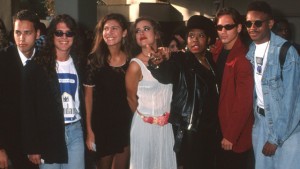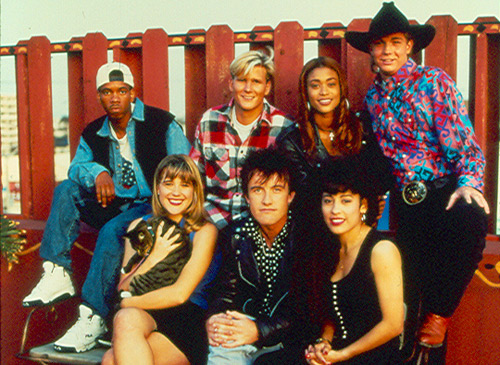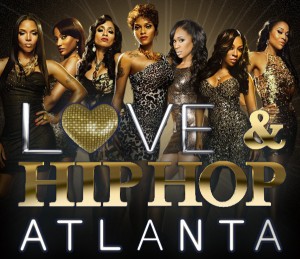
As a network developed to provide a new platform for music’s developing stars, MTV changed the lives of countless young artists looking for a break into the industry. During the 90s, MTV featured shows that primarily emphasized music: Yo! MTV Raps, MTV Unplugged, Alternative Nation, Club MTV, and Total Request Live are several programs that linked the entertainers and fans together by giving the fans control over what content aired. MTV’s popularity anchored itself in the young viewership of teens and young adults between the ages of 18-25; the pride of the network centered around creating a space dedicated to youth popular culture and the decade’s hottest rappers, rockers, and pop stars.
MTV also designed programming that focused on broader topics, like MTV News, in an effort to round out its offerings. The network’s longest running series, MTV’s The Real World, highlighted the day-to-day lives of young people from various backgrounds living together in a predetermined city. The show’s introductory tagline became ubiquitous with its content, and viewers could always count on an explosive combination of personalities to fuel each season’s unpredictable episodes:
“This is the true story of seven strangers, picked to live in a house, work together, and have their lives taped. Find out what happens when people stop being polite and start getting real…”
For twenty-five years, young people from different geographic locations and with varying backgrounds came together in cities throughout the country for our viewing pleasure, making The Real World the first successful reality television show broadcasted in America.
The Real World was modeled after Beverly Hills 90210 and Melrose Place, as an alternative to major network soap operas targeting middle-aged women. Mary-Ellis Bunim and Jonathan Murray, the show’s creators, opted for the “reality” format of The Real World, because their budget didn’t allow for writers, set design, actors, etc. So, they decided to let the participants create the storyline. The show’s first season was set in New York City and filmed over a three-month period, with each cast member receiving $2,600 for appearing on the show. And in New York, things got really real (well, at least according to mainstream TV content in the 90s).
What later becomes typical behavior amongst The Real World castmates was exciting and fresh during its 1992 debut (and for a few seasons thereafter). The thirteen episodes of Season One show Becky, Kevin, Heather, Julie, Andre, Eric and Norman working through romance, sex, illness, familial relationships, and social issues. The roommates are divided by gender 3:4 (female-to-male), and 5:2 ethnically (with two African-American cast members). Race plays a factor is several episodes, with Kevin Powell leading many conversations that highlight divisions within the house. His (in)famous confrontation with roommate Julie Gentry demonstrates the organic manner in which controversy arose, making the episodes worth watching.

The abridged version of the confrontation goes as follows: Julie accused Kevin of threatening her with physical violence and spitting at her after she refused to let him use their house phone (remember: this show’s original airing predates cell phones and all things technologically mobile). He admitted to being upset with her but denied spitting at her. When Norman and Eric sided with Julie, Kevin pointed to race as the underpinning for Norman and Eric’s alignment with Julie, but Julie sited what she determined as Kevin’s past record of aggressive behavior as the justification for her sentiments. The parties later reached some type of amicable resolution, but this episode created a precedent later followed by other seasons, where not only race, but religion, gender, and sexual orientation often divided the castmates. The show’s best moments are those credited for opening up tough conversations among young people.

Future roommates, almost always from various upbringings and of different ethic backgrounds, would confront similar issues: race, gender discrimination, differences concerning sexual orientation, political beliefs, body image issues, and religion. In Season Two, The Real World: Los Angeles, castmates Tami Akbar (m. Roman, later star of VH1’s Basketball Wives) and David Edwards divide the house after what begins as a prank targeting Tami. The incident escalated to a physical confrontation between the cast members, ultimately resulting in the decision to remove David from the house.
The Real World may be credited as the pioneering reality television program, and its influence remains evident in various popular “reality” TV shows on various networks. While there’s a show out there for a number of interests—meant quite literally, as every network, from HGTV to The History Channel, offers some reality-based series— few strike more intrigue than those offering insight into Black culture. More specifically, many shows feature African-American women feigning friendships, chasing men, and digging into entrepreneurial endeavors. And no Black reality TV show is complete until an episode features a shade-throwing-, tea-spilling-, let-me-get-you-together-type confrontation. The entertainment factor is undeniable, though, as shows like Bravo’s The Real Housewives of Atlanta and VH1’s Love & Hip Hop have reached ratings as high as 4.3 and 3.8 million, respectively.
Bunim and Murray’s reality TV formula allowed for an organic plot-development (although film was edited to help establish a traceable storyline), and the issues the casts encountered mimicked situations relatable to the audience. As The Real World progressed, audiences criticized producers for what many perceived as scripted conflicts and contrived conversations. It seems, however, that recent reality TV shows are only popular if the drama is “too good to be true.”
Nonetheless, our favorite reality starlets are also feeling a little shade from their fanbases, too. Ratings for many shows reflect a decline in viewership over the years, and in an effort to remain relevant, many storylines have expanded far too far away from “reality” (Do they have to fight every week?). And more troubling, for some, is what’s frequently cited as a collective misrepresentation of Black woman and the threat of conveying a distasteful, inaccurate message to young Black girls about Black womanhood in America.
Because of a history of oppression, subservience, dispossession of the body, abuse, malicious sexual intrigue, and marginalization by American at-large, we may question if Black reality TV supports or disrupts the perpetual race- and gender-based pursuit of acknowledgement, acceptance, and encouragement of Black women (and other women of color) in society. Are these women our entertainers, role models, or stereotype perpetuators? —Shari Arnold

References
<http://www.emmytvlegends.org/interviews/shows/real-world-the>
<http://www.usmagazine.com/entertainment/news/real-world-new-york-cast-reuniting-22-years-later-on-oprahs-show-20141712>
<https://lmarsh11.wordpress.com/tag/seven-strangers-picked-to-live-in-a-house/>
<http://www.theroot.com/articles/culture/2013/03/race_on_the_real_world_retro_mtv_and_social_issues.2.html>
<http://www.ibtimes.com/mtv-ratings-decline-raises-relevance-questions-young-people-cut-cable-cord-devices-1881468>
<http://allthingsrh.com/rhoa-ratings/>
<http://allhiphop.com/2015/05/08/is-love-hip-hop-languishing-in-ratings/>

